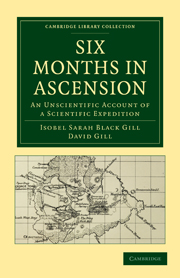Book contents
- Frontmatter
- INTRODUCTION
- Contents
- CHAPTER I WHY WE WENT
- CHAPTER II THE VOYAGE
- CHAPTER III ST. HELENA
- CHAPTER IV WHAT ASCENSION LOOKED LIKE
- CHAPTER V ASCENSION PAST AND PRESENT
- CHAPTER VI ROUND ABOUT GARRISON
- CHAPTER VII A NIGHT ON THE CLINKER
- CHAPTER VIII CHANGE AND CHECK
- CHAPTER IX MARS BAY
- CHAPTER X A SUNDAY SCENE
- CHAPTER XI THE OPPOSITION OF MARS
- CHAPTER XII THE SEA-SHORE AND THE ROLLERS
- CHAPTER XIII GREEN MOUNTAIN
- CHAPTER XIV SUNDAY AT THE MOUNTAIN
- CHAPTER XV WHY WE HAD ONLY A GALLON OF WATER
- CHAPTER XVI TRIPS FROM GARDEN COTTAGE
- CHAPTER XVII MARS BAY WITHOUT A COOK
- CHAPTER XVIII WIDE-AWAKE FAIR
- CHAPTER XIX LAST DAYS AT MARS BAY
- CHAPTER XX CHRISTMAS IN GARRISON
- CHAPTER XXI ABOUT THE KROOMEN
- CHAPTER XXII CLINKER CEMETERIES
- CHAPTER XXIII CHRISTMAS HOLIDAYS
- CHAPTER XXIV THE DEVIL'S RIDING SCHOOL
- CHAPTER XXV HOMEWARD BOUND
CHAPTER V - ASCENSION PAST AND PRESENT
Published online by Cambridge University Press: 05 July 2011
- Frontmatter
- INTRODUCTION
- Contents
- CHAPTER I WHY WE WENT
- CHAPTER II THE VOYAGE
- CHAPTER III ST. HELENA
- CHAPTER IV WHAT ASCENSION LOOKED LIKE
- CHAPTER V ASCENSION PAST AND PRESENT
- CHAPTER VI ROUND ABOUT GARRISON
- CHAPTER VII A NIGHT ON THE CLINKER
- CHAPTER VIII CHANGE AND CHECK
- CHAPTER IX MARS BAY
- CHAPTER X A SUNDAY SCENE
- CHAPTER XI THE OPPOSITION OF MARS
- CHAPTER XII THE SEA-SHORE AND THE ROLLERS
- CHAPTER XIII GREEN MOUNTAIN
- CHAPTER XIV SUNDAY AT THE MOUNTAIN
- CHAPTER XV WHY WE HAD ONLY A GALLON OF WATER
- CHAPTER XVI TRIPS FROM GARDEN COTTAGE
- CHAPTER XVII MARS BAY WITHOUT A COOK
- CHAPTER XVIII WIDE-AWAKE FAIR
- CHAPTER XIX LAST DAYS AT MARS BAY
- CHAPTER XX CHRISTMAS IN GARRISON
- CHAPTER XXI ABOUT THE KROOMEN
- CHAPTER XXII CLINKER CEMETERIES
- CHAPTER XXIII CHRISTMAS HOLIDAYS
- CHAPTER XXIV THE DEVIL'S RIDING SCHOOL
- CHAPTER XXV HOMEWARD BOUND
Summary
In order to make the process of taking root on Ascension intelligible, it is necessary first to explain something of the nature of its soil, and the peculiar manner of its cultivation. In other words, to make our own particular story less incoherent, it will be advisable, in the first place, to tell the little I know of the past history of our new home, and in what condition we found it in 1877.
Like its upturned face, the history of Ascension is featureless and colourless, being only redeemed from utter inanity by its contradictoriness. Doubtless there were stirring times here once on a day when Vulcan's forge was alight, but that was before we short-sighted mortals dared to peep into this now deserted workshop of the grimy god.
On Ascension Day, 1501, Juan de Nova, the great Portuguese navigator, found the fire gone out, and only hills of cinder and plains of ash to bear record of past labours. Ascension, so called by its discoverer from the fact of his having sighted it on Ascension Day, is one of the peaks of a submarine volcanic ridge which separates the northern and southern basins of the Atlantic, and is situated in lat. 8° S., long. 14° W., almost midway between the coasts of Africa and South America. It is one of the most isolated islands in the world, and has no land nearer than St. Helena, which lies 800 miles to the South-East.
- Type
- Chapter
- Information
- Six Months in AscensionAn Unscientific Account of a Scientific Expedition, pp. 57 - 68Publisher: Cambridge University PressPrint publication year: 2010First published in: 1878



